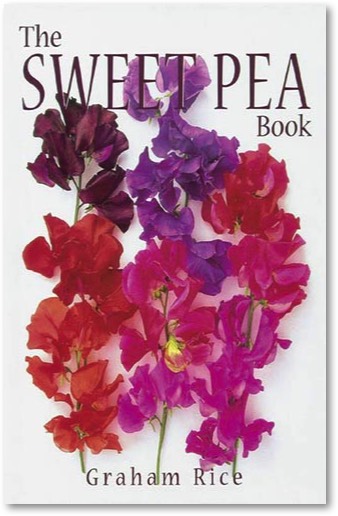
Musings » The Sweet Pea Book


Portland, Oregon
Timber Press 2002
There is a long series of books about the sweet pea. This delicate flower has had its champions since the late 1870s but the formal literary accompaniment began in 1892 with the Reverend William T. Hutchins’ All About Sweet Peas-an art monograph. The book was published by the W. Atlee Burpee company and followed five years later by another one, Sweet Peas Up-to-date. Both of these short works can be seen on the Cornell University website because of their historic importance.
In general the books have been written by specialists, most often people actively engaged in breeding new cultivars. Graham Rice is from a different mold. He had a thorough grounding in horticulture at the Royal Botanic Garden, Kew, but then branched out into horticultural writing. He brings a world of experience and knowledge to bear on any topic he chooses. We are lucky because this time he chose the sweet pea.
It is not a long book, being only 144 pages with all the appendixes and credits etc, but it packs a powerful punch. All the important topics are covered. There is a delightful section on the fascinating history which of course I found so enjoyable. The flower went to England in 1699 from Sicily but then a had a long dormant period in which very little happened to it. Ordinary gardeners grew it of course, but it was outside the whims of fashion. A few sports and other varieties emerged slowly, with the pink and white ‘Painted Lady’ being the next big change.
The modest sweet pea could not compete with the contemporary glittering imports like chrysanthemums, camellias, azaleas and so on. The actual flower was rather small, dark blue and purple, but its redeeming feature was a heavenly fragrance. The next time it was formally noticed, almost 200 years later, was in 1866 when the Royal Horticultural Society awarded a First Class Certificate to James Carter’s ‘Invincible Scarlet’ sweet pea cultivar at the flower show.
Ten years later Henry Eckford tied his career to improving sweet peas and created a sort of revolution. As if that were not enough, one of his cultivars developed a stunning sport and gave rise to a new phase of sweet pea breeding. The wind shifted toward the new ‘Spencers’, leaving Eckford’s old ‘Grandiflora series in the dust but he could still take comfort. The progenitor of the ‘Spencer’ line was his ‘Prima Donna’.
Today the classification of the sweet pea range of cultivars is quite complex but Rice lays it out rather well. Each page has at least one color picture, and sometimes two. Mrs Rice is the photographer.
The First World War ended one epoch and ushered in another. Breeders almost all over the world modified the flower intensively. In the recent past some English breeders have gone back to Eckford’s original line and are re-creating the ‘Grandiflora’ series. Rice includes good cultural information and helpful advice about where to buy the different kinds of seed.
The core of the book is a list of descriptions, allowing the amateur to choose carefully, depending on what type of flower one wants. Ten foot cordons of exhibition sweet peas are not too suitable for the small home garden. Climate is very important. During and just after WWI, breeders in California and New Zealand introduced many new cultivars which flowered early enough in the season to elude the withering heat of an American summer. It turns out that temperature is not the driver but the length of the day. One strange and fascinating by-product of the sweet pea frenzy was the rise of a sweet pea festival in Montana of all places. Sweet peas grew rather well in Bozeman.
The current line of research depends on where the breeders live. In the United States, climate tolerance and height are the governing factors. In the United Kingdom, ‘Spencers’ are still very important but in New Zealand, the work of one man is moving the field in another direction.
Keith Hammett, an English transplant in New Zaland, likes to tinker with patterns and stripes. He also seeks a pure yellow form and if anyone can do that it would be Keith. At one time he travelled widely in the Mediterranean region and found the flower which most resembles the one Cupani sent to London in 1699.
Graham Rice’s book is very useful. He covers everything you could possibly need to know.

